Meditation is a Core Thelemic Practice
“Let us determine to be masters of our minds.“
A.C., Book 4, Part I
Acceptance of the Law of Thelema and The Book of the Law are the only actual requirements to credibly identify as a Thelemite. However, some sort of personal magical regimen is needed to credibly identify as a Thelemic Magician. A huge range of practices are available for inclusion in the Thelemic Magician’s repertoire. Some of them, it seems to me, are foundational, and I include meditation in that category. Here’s why.
First, those of us who practice the observances of Liber Resh vel Helios sub figura CC are enjoined to compose themselves to holy meditation, a minimum of four times each day (for at least a short period of time).
Second, recall this passage from Liber Librae sub figura XXX:
“Fixed thought is a means to an end. Therefore pay attention to the power of silent thought and meditation. The material act is but the outward expression of thy thought, and therefore hath it been said that ‘the thought of foolishness is sin.’ Thought is the commencement of action, and if a chance thought can produce much effect, what cannot fixed thought do?”
Meditation, then (at minimum), is a way to develop and strengthen one of the faculties needed to conduct effective magical workings.
We can study what meditation means in other systems, but what, specifically, is the practice of meditation, or “fixed thought,” to a Thelemite? The answer to this question is thoroughly addressed in Crowley’s Book 4, Part 1. This book is essentially a treatise on meditation; and “Meditation” is, in fact, its subtitle. In Crowley’s preliminary remarks to this treatise, he succinctly defines meditation as, “the restraining of the mind to a single act, state, or thought.” He then proceeds to develop the idea of scientific meditation for the remainder of the treatise, showing us the necessary preliminaries (e.g. neutralization of distractions) as well as techniques for assessing progress.
So, very simply, when we meditate, we are attempting, for a set period of time, to restrain our mind to a single act, state, or thought. This can be practiced in a variety of ways, including (but certainly not limited to) focusing on such things as our posture, our breathing, a mantra, an image (the Tattvas are particularly convenient for this), a point on or inside the body (the Ajña chakra is often recommended), or even the ambient sounds around us. This can be considered an exercise to build strength or skill, similar to doing sit-ups or practicing a musical instrument. Frequent practice is essential; and slow, gradual progress is to be expected.

